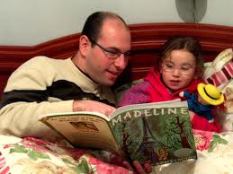 A frequently asked question I get is, “How do I know if a book is level appropriate for my child?” First, your child’s teacher can tell you what level your child is in a couple ways, via Lexile measure, grade equivalent/AR Level, guiding reading level, or DRA level. Teachers find what level your child is by using various tests and will typically give you one of these measures. Schools that I have previously taught at used grade equivalents and DRA. Teachers don’t usually use all 4, it’s just too much to manage.
A frequently asked question I get is, “How do I know if a book is level appropriate for my child?” First, your child’s teacher can tell you what level your child is in a couple ways, via Lexile measure, grade equivalent/AR Level, guiding reading level, or DRA level. Teachers find what level your child is by using various tests and will typically give you one of these measures. Schools that I have previously taught at used grade equivalents and DRA. Teachers don’t usually use all 4, it’s just too much to manage.
Next, when you are searching for a book, there are some apps for your SmartPhone that can assist you. From my perusal of the app store I found these to be the some options:
1. Level Finder $1.99 and 4+ Star and Consumer Rating: You can search for books based on grade equivalence only, but includes over 126,000 titles. You search by full or partial title, AR points, AR Level (gr. equiv.), and author name.
2. Level It Books $4.99 and 4+ rating: This is a relatively new app, so there aren’t any buyer reviews yet. However, this is a great tool for parents and teachers. You can scan the ISBN and easily get all four types of level reading levels for a book. You can look at teacher recommendations of books too. For teachers, you can keep rosters for checking out books and maintaining reading levels. This app also has a feature that allows you to loan out books using the check-out feature.
3. Book Retriever $.99 and 4+ rating but only 2.5 stars from consumer: This app has all of the same features as Level It Books does, but teachers can send parents notes via the app and you can print labels for your books too. Downside to this app, the consumer reviews say that is has functionality issues. Seems like they have some bugs to work out. However, one of the reviews states that a call to the company explaining the problem solved her issue with logging in.
Websites:
4. Scholastic Book Wizard is not an app but you could bookmark it in your browser on your phone. You can type in the title, keyword, or author of a book to retrieve reading level information. http://www.scholastic.com/bookwizard/
5. AR Book Find is also a great site for those of you who have children using the Accelerated Reader program or want grade equivalency. You can search via title, author, or keyword. http://www.arbookfind.com/usertype.aspx
If all else fails here is an idea, The Five Finger Rule. The premise is easy. Open to a page of the book and have your child read the page. One to two missed words means the book is too easy. 3 missed words means the book is just right. 4-5 missed words means the book is to difficult for independent reading. This rule is great with one caveat, ask your child to explain what he or she just read. Although, your child can read the words, he/she may not comprehend the text. If your child did not comprehend the text, it could also be because he/she is not interested in the book. Try a new book of interest or go back to a book that would be considered easy to see if the comprehension is better. I attached a PDF with the Five Finger Rule below. Now there’s no excuse…get your kiddo reading!
Five Finger Rule
Tags: book find, book report help, children with special needs, help, homework help, how to write a book report, reading, reading levels, teacher, Teaching, trouble with homework, tutoring, willow glen, willow glen tutoring




 ‘t, ask them about it. It’s a perfect opportunity to introduce new words.
‘t, ask them about it. It’s a perfect opportunity to introduce new words.


